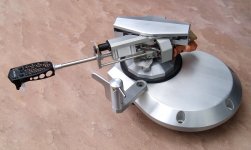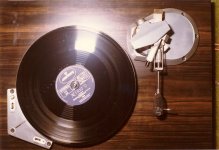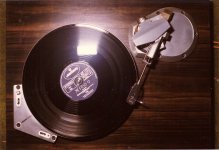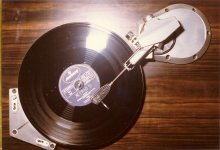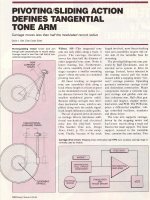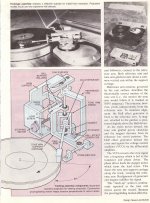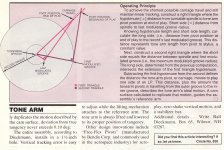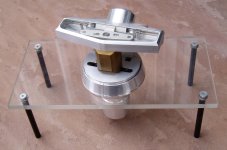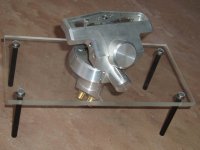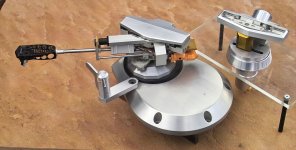Hello All,
In the 1980's I designed and built a Tangential Tone Arm. I patented it at the time, but the patent has since expired. I didn't pursue the idea, because CD's came on the market at just about that time. Having recently found out that vinyl is still very much around, I decided earlier in 2010 to improve the Tone arm. I am going to attach some photos, a magazine article and some drawings to explain how it works and then I'll make some comments about the new version of the Tone arm.
Sincerely,
Ralf
The first picture shows the original 1980's prototype.
The next three picture show the tone arm on a Micro-Seiki turntable in the:
A) Rest position,
B) The start of play position,
C) The end of play position
The Magazine Article is from the 4-22-1985 issue of Design News.
And the following three PDF files show how the geometry was developed.
In the 1980's I designed and built a Tangential Tone Arm. I patented it at the time, but the patent has since expired. I didn't pursue the idea, because CD's came on the market at just about that time. Having recently found out that vinyl is still very much around, I decided earlier in 2010 to improve the Tone arm. I am going to attach some photos, a magazine article and some drawings to explain how it works and then I'll make some comments about the new version of the Tone arm.
Sincerely,
Ralf
The first picture shows the original 1980's prototype.
The next three picture show the tone arm on a Micro-Seiki turntable in the:
A) Rest position,
B) The start of play position,
C) The end of play position
The Magazine Article is from the 4-22-1985 issue of Design News.
And the following three PDF files show how the geometry was developed.
Pictures
Here are the first three pictures which should have been in my first post. Ididn't realize I could only upload three pictures per post.
Ralf
Here are the first three pictures which should have been in my first post. Ididn't realize I could only upload three pictures per post.
Ralf
Attachments
My intermediate never to be finished prototype
Hi All,
In the late eighties I made an attempt to improve my tone arm but I couldn't get away from the overhead track upon which the carriage travels. It still looked too cumbersome, mechanically speaking. The attached pictures show the front and back of the tone arm base and track housing unit. The actual tone arm itself was never made. The large brass unit hanging from the track, is a dummy weight representing the tone arm to be. The transparent cover on top allows the reference arm and its associated cams to be viewed. All my tone arms have and will have this reference arm and associated cams in common.
Ralf
Hi All,
In the late eighties I made an attempt to improve my tone arm but I couldn't get away from the overhead track upon which the carriage travels. It still looked too cumbersome, mechanically speaking. The attached pictures show the front and back of the tone arm base and track housing unit. The actual tone arm itself was never made. The large brass unit hanging from the track, is a dummy weight representing the tone arm to be. The transparent cover on top allows the reference arm and its associated cams to be viewed. All my tone arms have and will have this reference arm and associated cams in common.
Ralf
Attachments
I'll try to keep it interesting.
Sincerely,
Ralf
I promise you,I skip right-over the 'fluff'.
This was interesting from the initial post.Bullseye!
Hello Shaun
As you requested, here is a comparison picture of the original prototype and what I call the intermediate version.
The large teardrop shaped base of the original prototype is not really part of the tonearm, rather it is an adapter so that I can mount the tone arm on my oversized Micro Seiki BL91L turntable. As you can see, the overhead track housing is the same on both tone arms. Except that the intermediate version has a transparent cover, so that the special cams and the cam follower can be seen.
Sincerely,
Ralf
As you requested, here is a comparison picture of the original prototype and what I call the intermediate version.
The large teardrop shaped base of the original prototype is not really part of the tonearm, rather it is an adapter so that I can mount the tone arm on my oversized Micro Seiki BL91L turntable. As you can see, the overhead track housing is the same on both tone arms. Except that the intermediate version has a transparent cover, so that the special cams and the cam follower can be seen.
Sincerely,
Ralf
Attachments
Hello All,
Now, that I’ve laid the ground work, I am going to post on the new 2010 version of my Tone Arm.
Things are going to progress more slowly from now on because I am building the Tone Arm as we speak, in Real Time, you might say. Of course I would have been done years ago if I hadn’t allowed the appearance of CDs to discourage me.
Over the years I have established certain features that I wanted to be in my Tone Arm:
1) The Tone Arm shall be of the Tangential type that freely pivots on a carriage that is designed to travel in a straight line, which runs through the center line of the platter of the turn table.
2) The pivot for vertical motion shall be level with the top of the LP.
3) This pivot shall not move up or down when VTA/VRA is adjusted.
4) The azimuth adjustment shall be as close to the Tone Arm pivot as possible.
5) The Tone Arm shall not have an offset head shell. ( No skating )
6) The Tone Arm shall freely pivot, to guarantee low horizontal and vertical mass.
7) If possible, the servo mechanism shall be mechanical rather than electronic.
8) At least, the pivots for vertical motion shall consist of “Free Flex Pivots”. http://www.flexpivots.com/swf/single.html
I have used the pivots in item 8) with success in my first prototype. They have no friction, no free play and require no lubrication, Ever. In addition, because these pivots are essentially rotary springs for limited angular rotation they can be used to apply the tracking force to the Tone Arm.
I am attaching three PDF files that show the 2010 version of my Tone Arm in the Rest, Start of play and End of play position. The tracks and the control mechanism have been hidden in the base.
Sincerely,
Ralf
Now, that I’ve laid the ground work, I am going to post on the new 2010 version of my Tone Arm.
Things are going to progress more slowly from now on because I am building the Tone Arm as we speak, in Real Time, you might say. Of course I would have been done years ago if I hadn’t allowed the appearance of CDs to discourage me.
Over the years I have established certain features that I wanted to be in my Tone Arm:
1) The Tone Arm shall be of the Tangential type that freely pivots on a carriage that is designed to travel in a straight line, which runs through the center line of the platter of the turn table.
2) The pivot for vertical motion shall be level with the top of the LP.
3) This pivot shall not move up or down when VTA/VRA is adjusted.
4) The azimuth adjustment shall be as close to the Tone Arm pivot as possible.
5) The Tone Arm shall not have an offset head shell. ( No skating )
6) The Tone Arm shall freely pivot, to guarantee low horizontal and vertical mass.
7) If possible, the servo mechanism shall be mechanical rather than electronic.
8) At least, the pivots for vertical motion shall consist of “Free Flex Pivots”. http://www.flexpivots.com/swf/single.html
I have used the pivots in item 8) with success in my first prototype. They have no friction, no free play and require no lubrication, Ever. In addition, because these pivots are essentially rotary springs for limited angular rotation they can be used to apply the tracking force to the Tone Arm.
I am attaching three PDF files that show the 2010 version of my Tone Arm in the Rest, Start of play and End of play position. The tracks and the control mechanism have been hidden in the base.
Sincerely,
Ralf
Attachments
Last edited:
- Status
- This old topic is closed. If you want to reopen this topic, contact a moderator using the "Report Post" button.
- Home
- Source & Line
- Analogue Source
- My 1980's Tangential Tone Arm and my 2010 improvement
